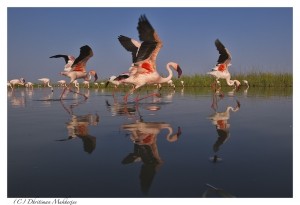End of the road for flamingos
By Prerna Singh Bindra
The unique natural heritage of the Great Rann of Kutch that Amitabh Bachchan promotes in the slick Gujarat Tourism commercials, is imperiled, ironically by a proposed road said to promote tourism.
Among the 130-odd projects that the new National Board for Wildlife cleared in its controversial first meeting in August last year, is a road that cuts through the Kutch Wildlife Sanctuary in Gujarat. The proposal for that road had been rejected, at least twice, by the NBWL in its last term, of which I was a member. Reason: It would endanger the only nesting ground of the greater and lesser flamingos in the Indian sub-continent, if not in all of south Asia, and lead to the probable extinction of the bird.
India’s best-known ‘bird man’ Late Dr Salim Ali gave the flamingo breeding site its popular nomenclature ’Flamingo City’ in 1945 after he counted no less than half-a-million flamingoes, Phoenicopterus roseus (and P. minor), or the ‘crimson water nymph’, here. The ‘City’ is the source, from where the flamingoes fly off across the sub-continent, to come back here to nest and breed, raise and ready their young, who then take wing, and thus continue the cycle of life.
There is a reason why flamingoes favour this particular portion of the Rann, over any other site. The peculiar conditions of this saline desert, inundated by rains to form a shallow, salty lagoon, make conditions ideal for the flamingos to breed, usually in September or October. Successful nesting is essentially a consequence of the dynamic flow of water. An influx of fresh water that flows in from the Luni river in Rajasthan, and also from North Gujarat and Pakistan, mingles with the saline water providing a rich flow of nutrients in which micro-organisms, crustaceans, algae and fish thrive — making a perfect meal, and breeding ground for flamingos, rosy pelicans, avocets, and a host of other birds.
The construction of the Gaduli-Santalpur road will impound the water, upsetting this cocktail of fresh and salty water; negatively affecting the food chain, thus threatening the fragile eco-system. A Ministry of Environment & Forests appointed expert committee report spells out the impending disaster, “if the proposed road is allowed to be constructed, it will in all probability result in the abandonment of this breeding site, and India will thus lose the only breeding site of the flamingoes, which could spell doom to the population of these birds in the Indian sub-continent.”
The Rann also harbours other unique wildlife such as wild ass, desert fox, desert cat, Great Indian Bustard, Indian wolf, caracal, Houbara Bustard etc, and is a critical passage for migratory birds from across the globe in to the Indian sub-continent. The road also skirts ‘Shravan Kavadia’, a unique mangrove system found nowhere else in the world – entirely cut off from the sea and over a 100 km inland of it.
The Gujarat state-endorsed proposal is ostensibly to provide greater access to the Border Security Force guarding the Indo-Pak border, as the Rann runs into the Sindh province in Pakistan. But that is the officially stated reason. The real motive is tourism, as reported in the media, concurred by the site visit report of the expert committee, and by officials, off the record.
The proposal “coincides” with the government’s effort to sell the White Rann as a major tourism attraction, and runs through many ‘tourism sites’, like Dhordo, promoted as a traditional village stay; Kala Dungar, ‘black hills’ and the highest point in Kutch; and the Harappan site of Dholavira, where an airport is on the anvil. The ancillary development and disturbance that a road and airport bring will further worsen the impacts.
Was there no way out? The NBWL expert committee reports approved an alternative route, “which is feasible, cost-effective, easy to build, would serve a greater use” and “would not have a significant impact”.
A certain ecological disaster, the road does not make economic sense either. The region remains inundated for about six months, and hence would be inaccessible. For the rest of the year, the entire flat expanse of the Rann is a road, and you could drive a sturdy vehicle anywhere.
The wildlife clearance to the road was given by the Standing Committee of the three-member National Board for Wildlife, appointed by the new government. Questioning the legality of the board, as it lacked the mandatory 15 non-official members as required by law, the Supreme Court stayed the board decisions. It however vacated the stay in November-end when a full board was constituted, in a decision that is likely to ensure the flamingos to extinction.
Gujarat has fiercely protected the endemic Asiatic lion, it should be a matter equal pride that it is the custodian of the flamingoes in the sub-continent and ensure its protection.
An edited form of this article appeared in the February 16, 2015 issue of the Outlook magazine
thanks to Dhritiman Mukherjee for the use of his photograph
